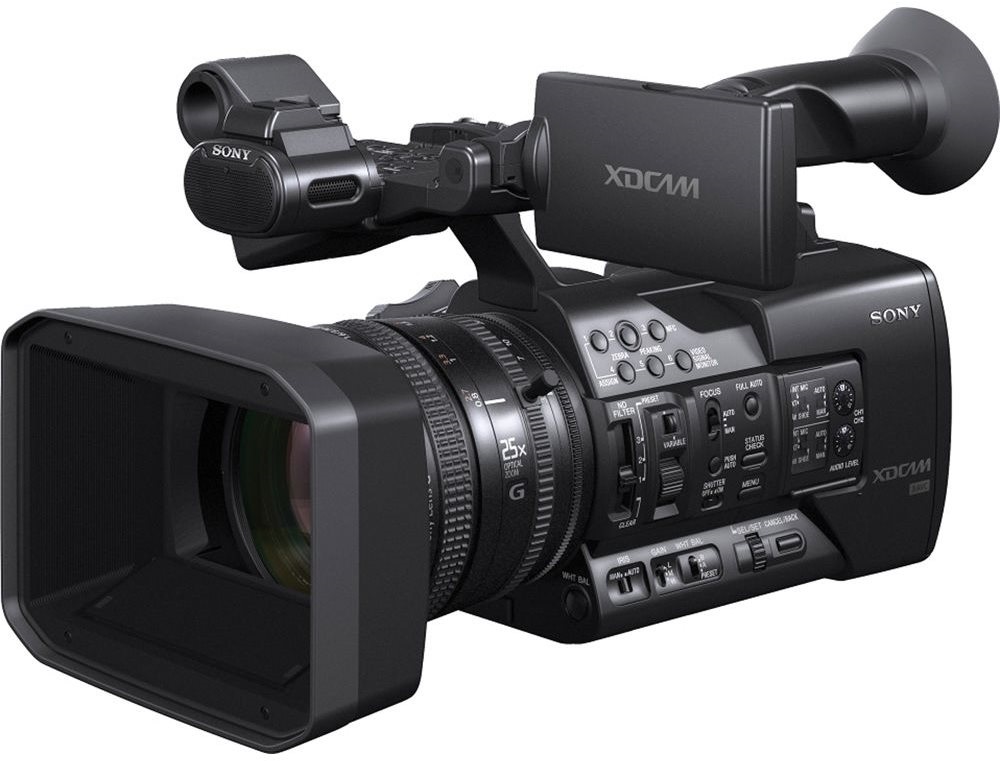

How to choose a professional video camera
Professional video cameras are designed for corporate videos, weddings, commercials, TV shows and other situations that require professional-level video recordings. They feature advanced optical systems, high-quality sensors, and powerful image processing. In short, professional video cameras offer the most extensive features and options available.

Advantages and disadvantages
Frequently asked questions when choosing a professional camera
How do I choose a memory card?
Several types of memory card are available. For semi-professional and professional video cameras, CF (Compact Flash) cards are suitable. Newer versions such as CFast 2.0 and XQD cards are smaller and faster (up to 440 MB/s) than the original CF. The most widespread memory card format is SD (Secure Digital); the newer and faster SDHC and SDXC cards are its technological successors.
What about capacity and speed?
Capacity ranges from 512 megabytes to 512 gigabytes. Video takes up large volumes of data, with one minute of Full HD video taking up tens to hundreds of megabytes. We recommend paying extra for a larger capacity as it's better to have too much than too little.
For speed, distinguish between read speed (how quickly files are transferred from the card to another device) and write speed (how quickly files are stored on the card while shooting video). Minimum write speed is divided into several classes.
| Class | Logo | Min. Write Speed | Suitable for |
| Class 2 |  | 2 Mb/s | SD video recording |
| Class 4 |  | 4 MB/s | HD video recording |
| Class 6 |  | 6 MB/s | HD video recording |
| Class 10 |  | 10 MB/s | Full HD video recording |
| UHS-1 |  | 10 MB/s | Broadcast video in real-time and record long HD videos |
| UHS-1 |  | 30 MB/s | 4K video recording |
This is the minimum guaranteed value of memory cards; in practice, they can achieve better results.
What else should I look for when choosing a camcorder?
Important parameters


Aperture
Aperture refers to the opening of a lens's diaphragm through which light passes. The bigger the aperture, the more light the lens is able to let through, which in turn effects the exposure time. Aperture also plays a crucial part in determining the depth of field, or the range of distance in an image that appears sharp. Aperture is measured in so-called f-numbers or f-stops.

Focal distance
The distance between the lens and the image sensor when the subject is in focus, usually given in millimeters. For everyday filming, a camcorder with a focal length of 40 mm is sufficient.

Data storage
Video cameras can be divided according to the way they store data, i.e. videos.
Memory cards - the most practical solution, memory cards hardly take up any space and are easily inserted in the camcorder.
MiniDV tapes - a tape-based technology, MiniDV allows you to edit frame by frame. The downside is that recordings take up more space than on other formats.
Combination of MiniDV tapes and memory cards - combined data storage is found on more expensive camcorders.
Internal memory - hard drives can be found not only in computers but also in some video cameras, providing capacity for up to several hours of recording.

Display
Important factors include the resolution and size of the display. Camcorders with tiltable screens are particularly useful if you want to shoot from unusual angles. Matte screens are recommended as they provide better visibility in bright sunlight.
A touch screen display is another useful feature; it allows you to both monitor and control the recording in the same place. One disadvantage, however, is the necessity to wear special touch-screen gloves in cold weather.

GPS
GPS, or Global Positioning System, allows you to record the location where the video was shot. This option is found in more expensive models.
Glossary - Video cameras
Lens
The lens directs and focusses light rays onto a camera's sensor chip. It is the most important part of a camera, and often also the most expensive. As a result, its characteristics significantly affect the overall quality of the photos and the camera itself.
An important parameter is the wide angle range of the lens, which is the maximum angle that a camera can capture. It is expressed in 35mm format. Wide-angle lenses are considered those with a wide angle range of less than 35mm, while ordinary cameras have a wide angle range of about 40mm.
Sensor
The sensor is one of the most important parts of a camera as it greatly affects the final image quality. Important factors to consider include the size of the sensor as well as the number of pixels. Although more pixels generally means better image quality, the size of the sensor is also important. Generally, if you have two cameras with the same number of pixels, but one has a larger sensor than the other, the one with a larger sensor should produce better-quality images.
Important parameters
- Sensor Size [cm] - the bigger the size, the better the resulting video
- Sensor Resolution [MP]
Basic cameras are often equipped with an 800,000-pixel chip.
The three-chip design is common in professional and semi-professional cameras. The three chips cooperate with the glass prism, which divides light into three directions. Each chip is in responsible for one part of the basic RGB colour spectrum (green, red, and blue).
CMOS sensors provide better, truer colour dynamics. While CMOS sensors don't produce the overall quality of three-chip sensors, they do offer better performance in poor light conditions.
Stabiliser
Stabilisation reduces the effects of camera shake. It can be divided into digital and optical stabilisation, the latter being part of the structure of the lens. Digital stabilisation uses software to reduce the effect of little movements, which involves increasing the camera's sensitivity to light (ISO). Optical stabilisation, on the other hand, is based on the movement of the lens in the optical system, which compensates for the effects of camera shake. Optical stabilisation is the more effective option.
Glossary

Resolution
Resolution indicates the number of pixels that make up an image or video. Although it is not the only critical parameter, it is true that the higher the resolution, the better the video quality.
HD - 1280 × 720 pixels - now considered insufficient for displaying video on a monitor
Full HD - 1920 × 1080 - sufficient for displaying video on a monitor or TV
4K resolution - the latest standard, 4K is gradually replacing Full HD